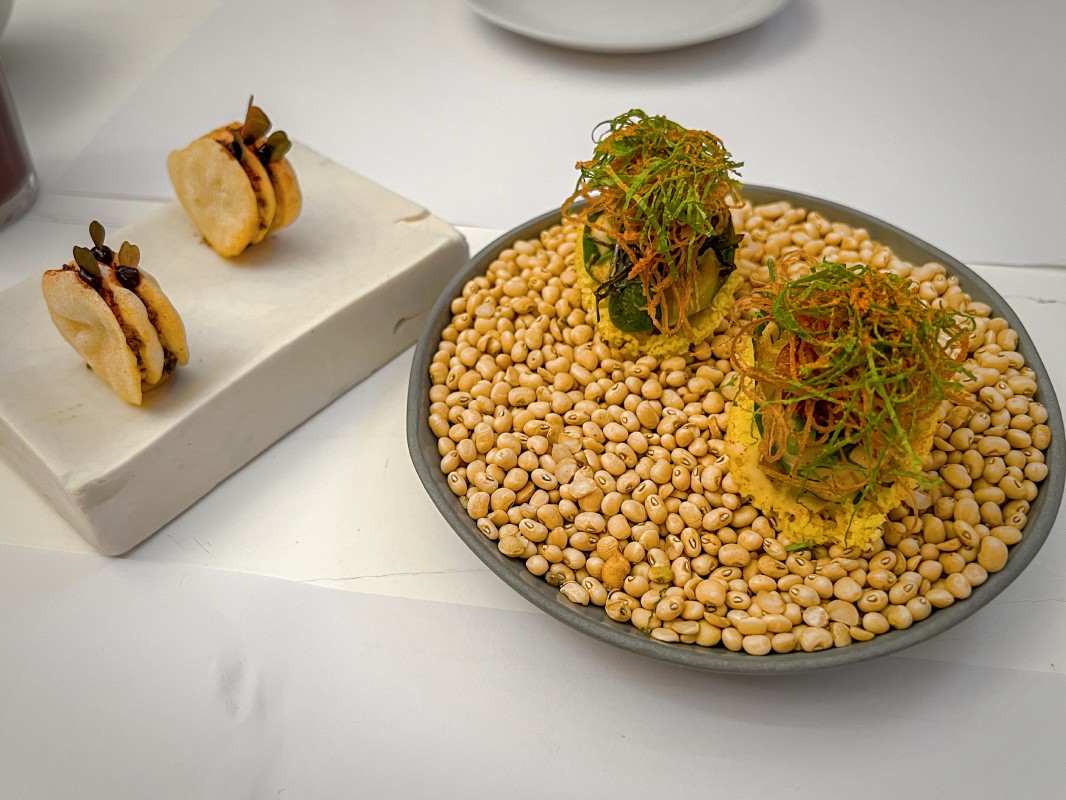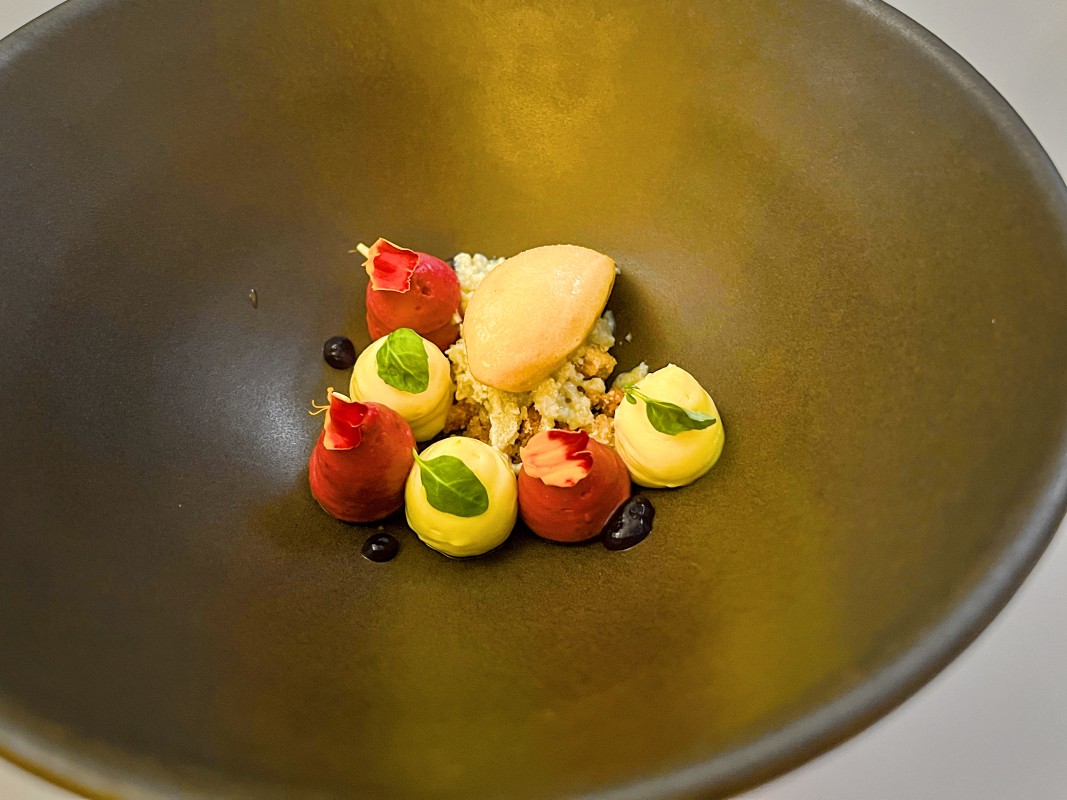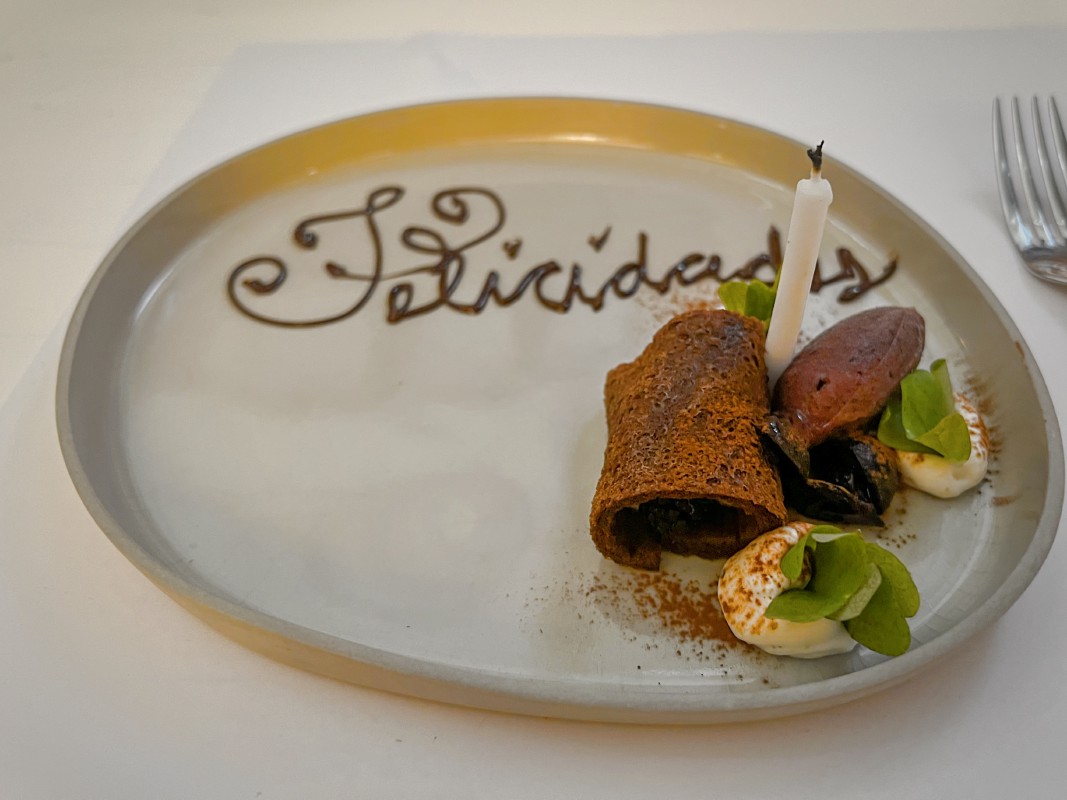Mani

Mani is a Michelin star Brazilian restaurant headed by chef Helena Rizzo and Willem Vandeven. My partner was adamant at getting reservations for this. Since the restaurant’s reservation system was a little odd at the time, my partner was talking to them through WhatsApp. Since Chef Helena Rizzo wasn’t going to be there during our reservation, she sent a birthday congratulations message thru Whatsapp to me, which I thought was very humble and extremely awesome.
We went here for lunch, and they offer tasting menus or a small prix fix. Looking over at other tables, the prix fix options looked very decadent and filling. If I ever come back to Mani, I would love to try these out. I did not opt for the wine tasting since I needed to give my gut some rest from all this deliciousness so far in Brazil.
Mani was also on the Latin America’s 50 Best Restaurants list in 2022 (ranked 21) and in 2019 (ranked 18).
Ambiance & Service
As you walk in, there’s a long corridor with side benches in the waiting area. On one side of the wall, you get a windowed view of the kitchen. As you walk through the restaurant, it goes through an indoor setting into a subtle outdoor setting.
We were seated in the backdoor covered patio. The ground was layered with rocks, and the lighting was bright since it was sunny outside. It was an interesting seating arrangement. There were also a lot of families with their kids eating here. This restaurant does not feel like an upscale restaurant, but it vividly reminds me of a very accessible, casual fine dining restaurant that was similar to my Marc Forgione experiences.
The main language here of course is going to be Brazilian Portuguese, but fortunately, they had a few staff that can speak English. They were able to explain each dish pretty well.
The tasting menu was R$680. By default, they charge 13% service fees. At the time of purchase, the currency ratio was 1 USD to 5.4 Brazilian Reals. Basically, take the price listed, and divide by 5.4, and that’s what the USD equivalency is.
Food

The Uva com Coco (R$26) came with grape juice mixed with coconut.

The amuse came with (clockwise starting at 9’o’clock):
- melão came with atum seco (dried tuna), fermented tomato powder, and dashi. This was just OK to me. Dried fish was never really something of much interest to me.
- manga verde came with carapau (horse mackerel), chuchu (cactus fruit), capuchinha (a flower), and jalapeño. The horse mackerel has a little fattier taste, but it can also have a stronger fishy taste as well.
- melancia (watermelon) came with carabineiro (water shrimp), ponzu, tomato, and borago. This was interesting in that it combined watermelon with some pretty strong shrimp flavors. It was not something I was expecting, and it was exquisite.
- jabuticaba(Brazilian tree grape) juice came with garum (fermented fish sauce), tomate, and amburana (legume plant). This juice was meant to drink last, and it actually was quite delicious.

The next small bites came with (left to right):
- Beiju (cassava cracker) came with feijão-manteiguinha (lime bean cream), carne de sol (sun-dried wagyu), pimenta biquinho (peppers), and maxixe. This reminded me of eating mashed black beans inside little crackers.
- Polvilho (fermented cassava starch shell) came with figado de galinha (chicken pate), nibs de cacau, mel de cacau (cocoa honey), and vinagreira (hibiscus). This was like a taco with pate fillings.

The ostra (native oyster) came with maça verde (green apple), cambuci (strong sweet sour fruit), pepino (cucumber), and raiz forte (horseradish). Below all this was an oyster from Brazil. The interesting thing about the oysters here is that it’s no where as briny as east coast oysters and also not as crisp as west coast oysters. The flavors were mild, but they were good.

The ova reconstruída (reconstructed roe from “tainha”, a local fish, which comes from Ilhabela in Sao Paulo state) with milho (corn), pancetta, and katsuobushi (bonito flakes). This was a chowder-like soup that had a substantial amount of fish roe in it. The roe was assembled inside a pork sausage casing burned with cachaca and lychee fruit. They took a spoon to dig out the roe and dumped it into the soup.

The peixde do dia (fish of the day) came with camarão seco (dried shrimp), dendê (palm fruit), amendoim (peanuts), and alface romana (romaine lettuce). Under the romaine leaf on the left was “frijilaba”, which I couldn’t figure out what fish that translated to. The server said it was a white fish from the Atlantic. Regardless, the meat was delicious. With the lettuce and dende, the whole thing tasted great.

The língua (tongue) came with beringela (eggplant), ora-pro-nobis (a vegetable), and jambo (rose apple). This was very delicious. On the top was Brazilian green chili sauce that wasn’t spicy at all but had a nice sweetness to it from the jambo.

The palmito (heart of palm) came with beldroega do mar (sea urchin), grated and smoked egg grinded on top, rabada (oxtail soup), and citricos (citrus). This was a very rustic and delicious dish.

The pato (duck) came with abóbora de pescoço (butternut squash), cebola (onion), nêspera (loquat), and miúdos (cream of duck innards). The duck was beautifully cooked and delicious. Everything else was similar to other restaurants, but it was definitely a little different. I’ve never seen the giblets made into a cream and served. This had that irony taste to it, but it was definitely seasoned to be very complementary to the sauce and the duck. Despite the thought of eating a cream of innards, it was actually pretty good.

The garrafada (medicine) came with cúrcuma (turmeric), lirio-do-brejo (ginger lily), vinagreira (hibiscus), cambuci (a type of fruit), uvaia (a Brazilian yellow fruit), poejo (a plant), pimenta-de-macaco (a Brazilian plant), and cachaça (Brazilian liquor). On the top is an ice cream of uvaia. The crumble is sweet with some peppers. The yellow dab is turmeric with a native lily flower dressed on top. The red one is hibiscus with orange. And lastly, the little dot is a cinnamon blue fairy intended for digestion. This turned out to be very light and floral.

The batata-doce roxa (pink sweet potato) came with bacuri (a Brazilian fruit) and rosas. This came with ribbon stripes that had the texture of Japanese mochi. The bacuri flavor was sweet and sour with hints of banana and mango, but also quite unique and delicious.

These petit-fours came with (starting bottom going counter clockwise):
- mandioquinha (cassava) with cheese crudo
- corn cake with guava jam
- geladinha (cold) ice pop
- caju fruit slices soaked in vanilla and cachaça. Caju is a the cashew apple that the cashew nuts come from.

This was a jabuticaba cake decorated with Brazilian spices and jabuticaba sorbet. Jabuticaba is a purple, black Brazilian grape. This was very good.

They gave us a large bag with a fresh, hot sack of tapioca chips.
Final Verdict
Mani was a fantastic restaurant that I really enjoyed. The food was all pretty darn good, and the atmosphere was very casual and non-pretentious. We highly recommend making a reservation here if you ever visit São Paulo.
Yelp Jabs
However, service could be better for a one Michelin star restaurant. Our server wasn’t as attentive as expected and there was poor communication. For example, food was removed from our table without asking.
Unfortunately this Elitist failed to realize that Michelin Stars are not awarded for service. It’s awarded for the food on the plate. In addition, this Elitist needs to realize tha the culture in Brazil is very different than Dublin (California) where they are from.
The portions were all a tad small, but I felt pretty full by the end. If I were to visit again, i’d probably go with the ala carte menu since the portions were much bigger.
For this Elitist, they didn’t realize that they described what a tasting menu is in their review. It’s supposed to be small portions with many courses. Yes, the a’la carte menu will have bigger portions, but one has to decide if they want to try different things, or just try the same thing in volume.
Revisions
- Jun 16, 2024 - Initial revision.